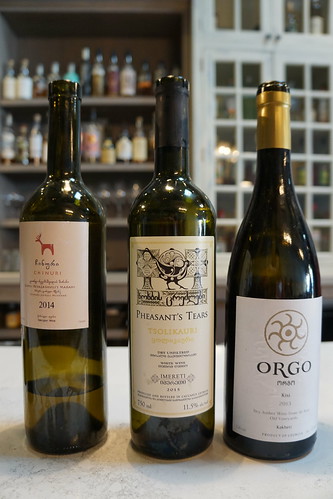Learning About the Wines of Georgia
I recently attended a tasting of wines from Georgia (the country, not the US state) and discovered there was much more I did not know about the world of wine! Traditionally made Georgian wines are unique, and if you've never had wines fermented in a qvevri, these wines would be completely unexpected for you. Most of the wines produced in Georgia are typically home winemakers who have been making wine for decades. There's no terroir codification and commercialization began pretty recently.
Just look at the colors, for instance:

Qvevri is an unlined terracotta vessel. They are buried in the ground and is cleaned after each vinification cycle. Since the vessel is unlined, there is air exchange happening through the pores of the terracotta throughout the fermentation. Prior to 2003, there was no commercially produced wine that uses qvevri, but then some producers decided to preserve the tradition.
Our wine tasting was led by Taylor Parsons, the sommelier from Republique in Los Angeles.
The first two wines I tasted were two Rkatsiteli from Niki Antadze. Niki Antadze is a tiny wine producer, with 3 hectares of vineyard in the Manavi, Kakheti regions. The Rkatsiteli is one of the main white grape varietals in Georgia.
Both Rkatsiteli were fermented in qvevri but without and with skin contact. You can see the colors are strikingly unique too.

The Rkatsiteli fermented in qvevri with no skin contact smells like beer (think honey ale) and yeasty. It had a beautiful acidity but it reminded me more of sour beers than wine! It was very unique. The one with skin contact also included some whole bunch clusters (stems added). It was fermented in qvevri for six months. It had some notes of honey syrup and tea, walnuts, more tannin. Good for fatty food.
Here are some more of my favorite wines we tasted that day:
Pheasant's Tears 2015 Tsolikouri from Imereti region.
Pheasant's Tears was started by an American who moved to Russia and then Georgia to study painting, but he ended up starting this winery in Georgia. This is one of the most important wineries in Georgia and he tries to connect Georgian wine makers with the outside world. Very interesting nose. Fermented acid but more clean and crisp than the others. Bee pollen. Woolly texture (like Chenin), a little bit of tannin.

Orgo 2013 Kisi from Kakheti.
Orgo is a small artisan winery in Kakheti and the Kisi uses grapes from 50-year-old vines. This wine has been fermented in qvevri for six months with skin contact using all native yeast. One of the cleaner skin-contact wines. Orgo uses very traditional tools but has excellent techniques. I loved the aroma of this wine.
Kindzmarauli 2014 Saperavi from Kakheti.
This is an off-dry/demi-sec wine. Demi-sec wines are in fact a big part of the wine production in Georgia - these are exported to China and Taiwan (it did occur to me that my mom would like it since it's sweet). It's pretty well-balanced for a demi-sec and is good to pair with bitter flavors.

Our Wine 2014 Rkatsiteli from Kakheti.
This was more clean-tasting, and pine-y but it had a very intense smoke and earthiness on the notes. You can taste the old vines. There are still tannins but you also get more fruitiness.

Orgo also makes a Saperavi that is aged in qvevri but then stabilized in stainless steel after. There are also a number of major European-style wine producers, such as Tbilvino, which makes 80 different wines - many aged tanks and oak barrels. The European-style wines still use the native grapes, so they are very good wines (for what most of the world is used to drinking) with its own special characteristics.
Next time you want to be adventurous with your wine choices, try a glass or bottle of Georgian wine. Start off gently with a European-style wine then move to the ones aged in qvevri!
The wine tasting was held at Puritan & Co and I just wanted to give them a shout out for keeping us fed with excellent food! I always love dining at Puritan and Co, and this time was no different. The lamb chops were excellent.




0 comments:
Post a Comment